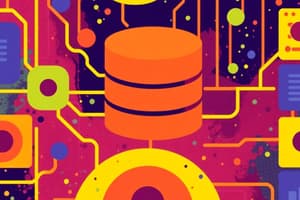Podcast
Questions and Answers
What is a database defined as?
What is a database defined as?
- A collection of related data with implicit meaning. (correct)
- A single piece of recorded information.
- A set of instructions for a computer program.
- A collection of unrelated information.
Which of the following is an example of data that might be stored in a database?
Which of the following is an example of data that might be stored in a database?
- Song lyrics.
- Names, telephone numbers, and addresses. (correct)
- The source code of a video game.
- A computer's operating system.
What is the primary purpose of a database?
What is the primary purpose of a database?
- To store and manage data for a specific purpose. (correct)
- To store data for no specific reason.
- To execute computer programs.
- To display graphical user interfaces.
Which of the following is an example of a database system?
Which of the following is an example of a database system?
What causes the information in a database to change?
What causes the information in a database to change?
Which aspect of database design does the logical database designer primarily focus on?
Which aspect of database design does the logical database designer primarily focus on?
What is the main responsibility of the physical database designer?
What is the main responsibility of the physical database designer?
Who is responsible for building applications that allow end-users to access the database?
Who is responsible for building applications that allow end-users to access the database?
Who are the 'clients' or actual consumers of the database?
Who are the 'clients' or actual consumers of the database?
Which of the following is an example of an end-user?
Which of the following is an example of an end-user?
What must a database be to ensure accuracy and reliability?
What must a database be to ensure accuracy and reliability?
Which of the following is an example of a very large database?
Which of the following is an example of a very large database?
For what type of databases is a file-based system most appropriate?
For what type of databases is a file-based system most appropriate?
What is a key limitation of file-based systems when generating reports and summaries?
What is a key limitation of file-based systems when generating reports and summaries?
What is a common problem in file-based systems related to data?
What is a common problem in file-based systems related to data?
What does 'data dependence' refer to in the context of file-based systems?
What does 'data dependence' refer to in the context of file-based systems?
What is a major limitation regarding queries in a file-based system?
What is a major limitation regarding queries in a file-based system?
What is the primary function of a Database Management System (DBMS)?
What is the primary function of a Database Management System (DBMS)?
What is the purpose of Data Definition Language (DDL)?
What is the purpose of Data Definition Language (DDL)?
Which language is used to insert, delete, update, and retrieve data?
Which language is used to insert, delete, update, and retrieve data?
What is the primary purpose of access control features in a DBMS?
What is the primary purpose of access control features in a DBMS?
Which of the following is a function of a database application program?
Which of the following is a function of a database application program?
What is a 'view' in the context of databases?
What is a 'view' in the context of databases?
Which of the following is a major component of a DBMS environment?
Which of the following is a major component of a DBMS environment?
What do 'Procedures' refer to in a DBMS environment?
What do 'Procedures' refer to in a DBMS environment?
Who is responsible for the physical realization of the database?
Who is responsible for the physical realization of the database?
Flashcards
Database Definition
Database Definition
A collection of related facts with implicit meaning.
Flight Booking System Database Example
Flight Booking System Database Example
Tracking customer, flight, and airport details.
Registry System Database
Registry System Database
Managing student, lecturers, and course information.
Library Resource Management System
Library Resource Management System
Signup and view all the flashcards
Database Purpose
Database Purpose
Signup and view all the flashcards
Logical Database Designer
Logical Database Designer
Signup and view all the flashcards
Physical Database Designer
Physical Database Designer
Signup and view all the flashcards
Application Developer
Application Developer
Signup and view all the flashcards
End-Users
End-Users
Signup and view all the flashcards
Naive Users
Naive Users
Signup and view all the flashcards
Data Definition Language (DDL)
Data Definition Language (DDL)
Signup and view all the flashcards
Data Manipulation Language (DML)
Data Manipulation Language (DML)
Signup and view all the flashcards
Database Access Control
Database Access Control
Signup and view all the flashcards
Database Maintenance
Database Maintenance
Signup and view all the flashcards
Database Application Program
Database Application Program
Signup and view all the flashcards
Database Views
Database Views
Signup and view all the flashcards
DBMS Hardware
DBMS Hardware
Signup and view all the flashcards
DBMS Software
DBMS Software
Signup and view all the flashcards
Database Management System (DBMS)
Database Management System (DBMS)
Signup and view all the flashcards
Database Accuracy
Database Accuracy
Signup and view all the flashcards
File-Based Systems
File-Based Systems
Signup and view all the flashcards
Separation and Isolation (File-Based)
Separation and Isolation (File-Based)
Signup and view all the flashcards
Duplication (File-Based)
Duplication (File-Based)
Signup and view all the flashcards
Data Dependence (File-Based)
Data Dependence (File-Based)
Signup and view all the flashcards
Incompatible File Format
Incompatible File Format
Signup and view all the flashcards
Fixed Queries
Fixed Queries
Signup and view all the flashcards
Study Notes
- CSC1022 is an introduction to databases course
- The instructor is Dr. Yalemisew Abgaz at Dublin City University's School of Computing
Outline
- A definition of what a database is
- The usage of a database
- Large databases
- File-based systems
- Database Management Systems
- Components of database systems
- Roles of database users
Definition: Databases
- A database is a collection of related data
- Data consists of known facts that can be recorded and have implicit meaning
- Examples include names, telephone numbers, and addresses
- This data can be recorded in an indexed address book, a hard drive, or using software like Excel
- Flight booking systems, registry systems(student info), and library resource management systems are example databases
Usage
- A database is designed, built, and populated with data for a specific purpose
- Databases have intended users with preconceived applications
- Databases derive data from a source, engage with real-world events, and have an interested audience
- End users perform business transactions or experience events that change database information
- A database must be a true reflection of the real world and changes must be reflected as soon as possible
Large Databases
- Google uses exabytes (~10^18) and zettabytes (~10^21)
- Other examples of large databases:
- Youtube
- Amazon
- World Data Centre for Climate
- AT&T
- Library of Congress
File-based Systems
- A collection of application programs that perform services for end users, such as resource production
- Applicable for small databases storing data about a few entities
- Applicable when a stand-alone system is used and doesn't require sophisticated reporting
- File-based systems fail with increasing demands for reports and summaries, requiring a huge effort to generate them or a huge amount of data updates
Problems of File-Based Systems
- Separation and Isolation: Difficult to integrate files and keep track of data when stored separately, which makes synchronisation and utilisation difficult
- Duplication: File-based approach duplicates data, such as lecturer information for both IT and Business students
- Data Dependence: Access relies on the program reading/writing data, making it difficult to read with another program and requiring code changes when the data structure changes
- Incompatible File Format: Compatibility between files of different programming languages is difficult
- Fixed Queries: Difficult to run varied queries due to pre-processed queries and specific functions
Database Management Systems
- DBMS is a program that interacts with the database, allowing users to define, create, maintain, and control access
- Data Definition Languages (DDL) define the database and describe data details and storage
- Data Manipulation Languages (DML) allow users to insert, delete, update, and retrieve data
- Access control features allow users to manage access, maintain security, integrity, recovery, and metadata services
Database Application Program
- A computer program that interacts with the database system using requests to the DBMS
- Views: can view specific data parts, provide security by restricting data from unauthorized users, customize the database appearance, and present a consistent picture of the database
Components of DBMS Environment
- There are 5 major components:
- Hardware: Stores, manipulates, and controls data from a single computer to a Mainframe server
- Software: The DBMS, applications, and network software
- Data: The most important aspect from the user's perspective, containing operational data and metadata
- Procedures: Instructions and rules governing database design and use, including login and back-up procedures
- People: Designers, programmers, and users, categorized into four types
Roles of Database Users
- 4 categories of users: Data and Database Administrators, Database Designers, Application Developers, and End-users
Data and Database Administrators
- Data Administrator (DA): manages the data resource, including planning, development, maintenance of standards, policies, and procedures
- Database Administrator (DBA): focuses on physical realization, design, implementation, security, integrity, maintenance, and performance
Database Designers
- Logical database designer identifies data entities, attributes, relationships, and constraints
- Physical database designer determines how the logical design is physically realized, requiring technical and business knowledge of the target DBMS
Application Developers
- Responsible for building or implementing applications that enable end users to access the database
End-Users
- The "clients" and actual consumers of the database who may be Naive or sophisticated users
Studying That Suits You
Use AI to generate personalized quizzes and flashcards to suit your learning preferences.
Related Documents
Description
An introduction to databases, their usage, and database management systems. Includes components, users, and how they compare to file-based systems. Examples provided are flight booking, registries, and library management systems.




